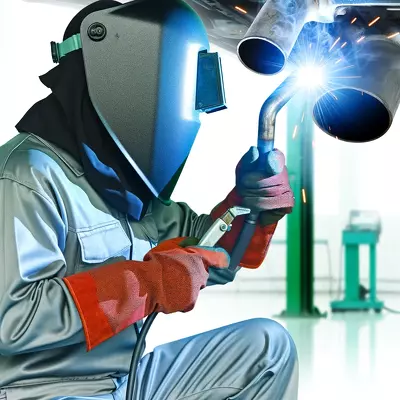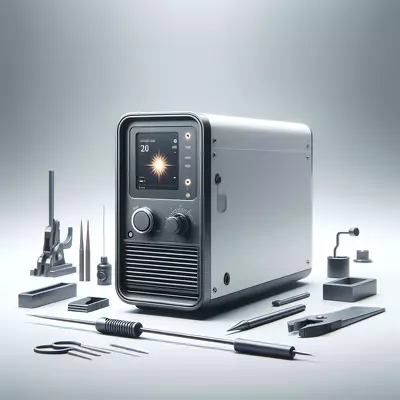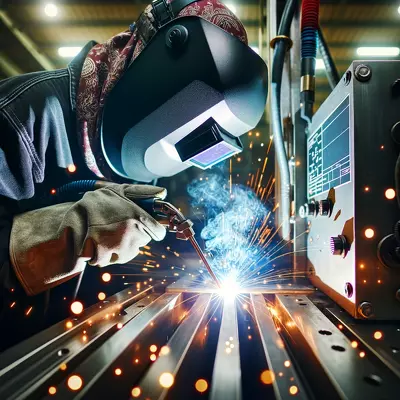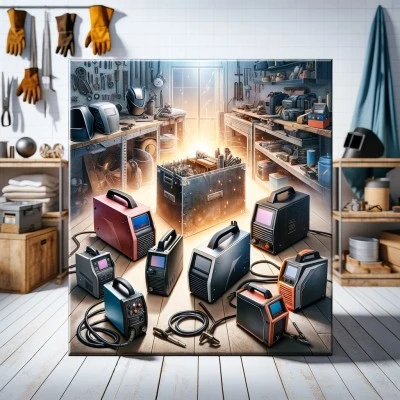Beyond the Basics: Elevating Your Skills with the Best Welder for Exhaust Pipe Work

Choosing the right welder for exhaust pipe repairs or modifications is crucial for automotive enthusiasts and professionals alike. This tool must offer precision, durability, and the ability to handle the unique challenges of welding automotive exhaust systems. With various options on the market, from MIG to TIG welders, understanding the specific features that make a welder suitable for exhaust work can save time and ensure quality results.
As an Amazon Associate, we earn a commission from qualifying purchases.
I. Introduction
The quest for the ideal welder for exhaust pipe work is a critical consideration for both automotive professionals and enthusiasts. The integrity of an exhaust system affects not only a vehicle’s performance but also its environmental footprint and safety. This article delves into the nuances of selecting the best welders, focusing on their types, features, and the specific needs they address in exhaust pipe welding.
II. Understanding Welders for Exhaust Pipe Work
A. Importance of Welder Type
Welding exhaust pipes requires a tool that can handle the delicate nature of thinner metals typically used in automotive exhaust systems. Metal Inert Gas (MIG) welders are often highlighted as the superior choice for such tasks due to their capability to provide cleaner welds with less spatter, making them ideal for the precision required in exhaust repair and fabrication.
B. Key Features to Look For
When selecting a welder for exhaust work, key features such as adjustable heat settings, a stable arc, and user-friendly interfaces are crucial. These features ensure that the welder can be finely tuned to handle the specific challenges posed by welding thin metals without causing damage or unnecessary stress to the material.
C. Safety Considerations
Safety is paramount in welding, more so when dealing with the complexities of exhaust systems. Features such as thermal overload protection, a robust grounding clamp, and the inclusion of safety gear are essential. Additionally, a well-ventilated workspace is critical to avoid the inhalation of harmful fumes.
III. Review of Top Welders for Exhaust Pipes
A. YESWELDER Digital MIG-205DS MIG Welder
- Specifications and Features
This model boasts a dual voltage capability, allowing it to operate on both 110 and 220 volts, making it versatile for different settings. It supports MIG, Lift TIG, and ARC welding processes, offering flexibility for various projects. - Pros and Cons
The YESWELDER MIG-205DS is celebrated for its adaptability and ease of use, featuring a digital display for precise control. However, its versatility can also be a drawback for users looking exclusively for a specialized exhaust pipe welding solution. - Best Use Scenarios
Ideal for both hobbyists and professionals, its multi-process capabilities make it suitable for a wide range of welding tasks beyond exhaust systems, including fabrication and repair work on other automotive parts.
B. Lincoln Electric SP-140T MIG Welder
- Specifications and Features
The Lincoln Electric SP-140T is designed for high-quality welds on a variety of metals, including stainless steel and aluminum, which are common in exhaust systems. Its user-friendly interface makes it accessible for welders of all skill levels. - Pros and Cons
Its strength lies in its consistency and reliability, providing smooth welds with minimal spatter. However, its price point and weight might be limiting factors for non-professional users. - Best Use Scenarios
This welder is most suited for professionals in automotive repair shops or individuals committed to regular exhaust pipe maintenance and modifications.
C. Hobart 500554 Handler 190 MIG Welder
- Specifications and Features
With a powerful output and the ability to weld a wide range of thicknesses, the Hobart Handler 190 is a robust option for serious welders. It also supports spool gun use for aluminum welding, a common requirement for exhaust work. - Pros and Cons
The main advantages are its power and versatility, which makes it capable of handling various welding jobs with ease. On the downside, its size and complexity may appeal to only some. - Best Use Scenarios
Perfect for those requiring a heavy-duty welder for extensive exhaust system repairs or for use in a professional setting where a variety of welding tasks are common.
IV. Best Welding Practices for Exhaust Pipe
A. Preparing the Exhaust Pipe for Welding
- Cleaning and Surface Preparation
The success of welding exhaust pipes begins with thorough cleaning and preparation of the surfaces to be welded. Removing any rust, oil, and contaminants ensures a stronger weld and reduces the risk of weld defects. - Cutting and Fitting Techniques
Precise cutting and fitting are essential for a seamless weld. Techniques such as tack welding at intervals can help hold the pieces in place and prevent warping during the welding process.
B. Welding Techniques for Exhaust Pipes
- MIG Welding Techniques
MIG welding is preferred for its efficiency and the clean, strong welds it produces on thinner metals. Proper technique involves controlling the speed and angle of the weld to prevent burn-through and ensure penetration. - TIG Welding Techniques
Although TIG welding is less commonly used for exhaust work, it offers superior control for intricate welds. This method is ideal for custom fabrication or when working with exotic materials.
C. Post-Welding Practices
- Cooling and Cleaning
After welding, it’s important to allow the exhaust pipe to cool naturally. Abrupt cooling can cause stress and warping. A post-weld clean-up removes any residual slag or spatter, ensuring a clean finish. - Inspection and Testing
A thorough inspection for leaks or weak welds is crucial. Testing under operational conditions can help identify any issues before the vehicle is put back into service.
V. FAQs
Q: What is the best type of welder for exhaust pipework?
A: MIG welders are generally considered the best choice for welding thinner metals found in exhaust pipes due to their precision and clean welds.
Q: Can I use a TIG welder for exhaust pipes?
A: Yes, TIG welding can be used for exhaust pipes, especially for custom work or when welding exotic materials, offering superior control over the weld.
Q: How do I prepare an exhaust pipe for welding?
A: Cleaning the pipe thoroughly to remove rust, oil, and dirt and then cutting and fitting the pieces precisely are crucial steps before welding.
Q: What safety gear do I need for welding exhaust pipes?
A: Essential safety gear includes a welding helmet with proper filtration, gloves, protective clothing, and adequate ventilation to avoid inhaling fumes.
Q: Can I weld an exhaust pipe without removing it from the vehicle?
A: While it’s possible, removing the exhaust pipe is recommended to ensure thorough and safe welding and avoid damage to the vehicle.
Q: How do I avoid warping the pipe while welding?
A: Using tack welds to hold the pieces in place and controlling the heat input can prevent warping. Allowing the metal to cool naturally is also important.
Q: Are there any welders that are portable and suitable for exhaust work?
A: Yes, several welders offer portability without compromising on the power and features needed for effective exhaust pipe welding, such as the YESWELDER Digital MIG-205DS.
VI. Conclusion
A. Best Offer
The YESWELDER Digital MIG-205DS stands out as the best welder for exhaust pipework, offering versatility, ease of use, and the adaptability required for both professional and hobbyist projects.
B. The Alternative
For those seeking a more focused, professional-grade option, the Lincoln Electric SP-140T MIG Welder offers exceptional quality and reliability, making it a superb alternative for dedicated automotive repair work.
VII. Suggested Readings
The world of welding is vast and filled with resources for those eager to learn more. Whether you’re a novice looking to get started or a seasoned professional seeking to refine your skills, the following books offer valuable insights and techniques:
- “Welding For Dummies” by Steven Robert Farnsworth – A beginner-friendly guide that covers the basics of welding, including equipment, techniques, and safety measures.
- “The Welder’s Handbook: A Complete Guide to MIG, TIG, Arc & Oxyacetylene Welding” by Richard Finch – This comprehensive manual offers in-depth information on various welding methods, with a focus on practical applications and professional tips.
- “Automotive Welding: A Practical Guide” by Jeffrey Zurschmeide – Specifically tailored to automotive welding, this book covers everything from basic repairs to advanced fabrication techniques, making it ideal for those interested in exhaust pipe welding.
- “Metal Fabricator’s Handbook” by Ron Fournier – For those interested in custom fabrication work, this book provides expert advice on working with metal, including cutting, bending, and welding, with a focus on automotive applications.
These resources serve as a foundation for both understanding and mastering the art of welding, offering step-by-step guides, practical advice, and detailed explanations of techniques. Whether you’re just starting or looking to expand your skills, the knowledge contained within these pages will be an invaluable asset on your journey.






